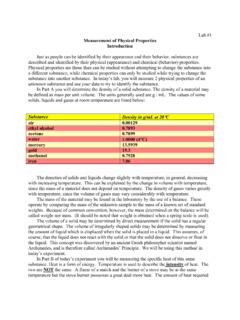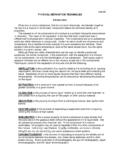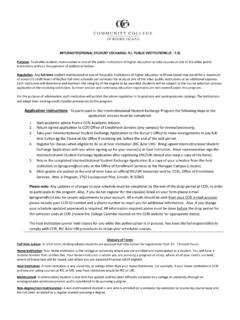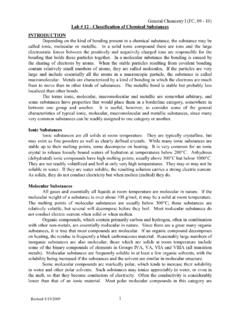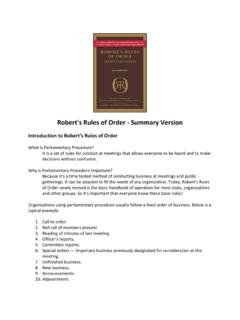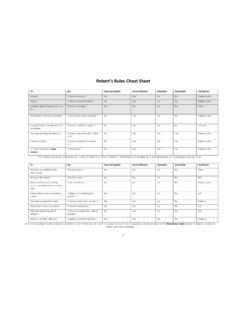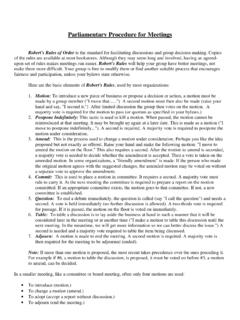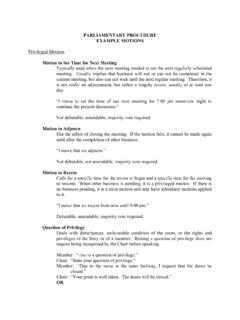Transcription of ROBERT’S RULES OF ORDER - Community College of …
1 ROBERT S RULES OF ORDER What are Robert s RULES of ORDER ? The first edition of the book was published in February, 1876 by Army Major Henry Martyn Robert. Its procedures were loosely modeled after those used in the United States House of Representatives. Robert wrote Robert s RULES of ORDER after presiding over a church meeting and discovering that delegates from different areas of the country did not agree about proper procedure. The book is now in its 10th edition; Robert s RULES of ORDER Newly Revised (RONR). Robert s RULES of ORDER provides applicable RULES governing key matters of meeting and general procedures, including: Establishing a Constitution and Bylaws for your student organization. Structure of the meeting Agenda and debate. Motions; including making, seconding, debating, modifying and amending motions.
2 Sufficient majority and simple majority and which decisions are appropriate to them. Establishment of a quorum. Definition of membership. Voting rights of presiding officer and voting procedures. AN OUTLINE OF BASIC PARLIAMENTARY PROCEDURE Prepared by Douglas N. Case Parliamentary Authority: Robert's RULES of ORDER , Newly Revised, Tenth Edition, 2001. I. RULES Governing an Organization State and Federal Law - governing corporations, tax-exempt organizations, public legislative bodies, etc. Articles of Incorporation - applicable to corporations Governing Documents of Parent Organizations - applicable to chapters, affiliates, etc. of larger organizations D. Local Constitution and Bylaws - defines the organization's basic structure and fundamental RULES .
3 Normally requires a 2/3 vote and prior notice for amendment and are not subject to suspension. E. Standing RULES - operating procedures consistent with all of the above. Normally can be amended by majority vote at any business meeting and can be suspended. F. RULES of ORDER - parliamentary authority, superseded by any of the above that conflict. Precedent and Custom - apply when there are no written RULES governing a situation. II. Purposes of Parliamentary Procedure Ensure majority rule Protect the rights of the minority, the absentees and individual members Provide ORDER , fairness and decorum Facilitate the transaction of business and expedite meetings III. Basic Principles of Parliamentary Procedure All members have equal rights, privileges and obligations.
4 A quorum must be present for the group to act if the bylaws of the organization do not establish a quorum, the general rule is that a majority of the entire membership must be present in ORDER to transact business. Full and free discussion of every motion is a basic right. Only one question at a time may be considered, and only one person may have the floor at any one time. Members have a right to know what the immediately pending question is and to have it restated before a vote is taken. No person can speak until recognized by the chair. Personal remarks are always out of ORDER . A majority decides a question except when basic rights of members are involved. A two-thirds vote is required for any motion that deprives a member of rights in any way ( , cutting off debate).
5 Silence gives consent. Those who do not vote allow the decision to be made by those who do vote. The chair should always remain impartial. IV. Typical ORDER of Business A. Call to ORDER B. Opening Exercises, if applicable C. Roll Call/Determination of a Quorum D. Adoption of the Agenda E. Reading and Approval of the Minutes of the Previous Meeting F. Reports of Officers G. Reports of Standing Committees H. Reports of Special (Ad hoc) Committees I. Special Orders J. Unfinished Business and General Orders K. New Business L. Program, if applicable M. Announcements N. "Good of the ORDER " O. Adjournment V. Role of the Presiding Officer A. Remain impartial during debate - the presiding officer must relinquish the chair in ORDER to debate the merits of a motion B.
6 Vote only to create or break a tie (or 2/3 for matters requiring a 2/3 vote) exception: the presiding officer may vote on any vote by ballot C. Determine that a quorum is present before transacting business D. Introduce business in proper ORDER E. Recognize speakers F. Determine if a motion is in ORDER G. Keep discussion germane to the pending motion H. Maintain ORDER I. Put motions to a vote and announce results J. Employ unanimous consent (general consent) when appropriate VI. General Procedure for Handling a motion A. A member normally must obtain the floor by being recognized by the chair. B. Member makes a motion . C. A motion must normally be seconded by another member before it can be considered. Before the motion is restated by the chair, any member can rise, without waiting to be recognized, and suggest a modification of the wording to clarify the motion .
7 The maker of the motion can choose to accept or reject the modified wording (does not require a second). If the motion is in ORDER , the chair will restate the motion and open debate (if the motion is debatable). The maker of a motion has the right to speak first in debate. Debate is closed when: 1. Discussion has ended, or 2. A two-thirds vote closes debate ("Previous Question") H. The chair restates the motion , and if necessary clarifies the consequences of affirmative and negative votes. I. The chair calls for a vote. J. The chair announces the result. K. Any member may challenge the chair's count by demanding a Division of the Assembly. VII. General RULES of Debate A. No members may speak until recognized by the chair. B. All discussion must be relevant to the immediately pending question.
8 C. No member may speak a second time until every member who wishes to speak has had the opportunity to do so. D. No member can speak more than twice to each motion . E. No member can speak more than ten minutes. F. All remarks must be addressed to the chair no cross debate is permitted. G. It is not permissible to speak against one s own motion (but one can vote against one's own motion ). H. Debate must address issues not personalities no one is permitted to make personal attacks or question the motives of other speakers. I. The presiding officer must relinquish the chair in ORDER to participate in debate and cannot reassume the chair until the pending main question is disposed of. J. When possible, the chair should let the floor alternate between those speaking in support and those speaking in opposition to the motion .
9 K. When a large number of people wish to speak to a motion it may be advisable for the chair to make a speakers' list. L. Members may not disrupt the assembly. M. RULES of debate can be changed by a two-thirds vote. VIII. Motions in Ascending ORDER of Precedence Only one main motion may be on the floor at a time, but more than one secondary motion may be on the floor. When any of the motions on the following list is the immediately pending motion ( , the last motion made), any motion listed below it on the list can be made at that time and any motion above it on the list cannot be made at that time. Pending motions must be disposed of in descending ORDER of precedence. A. Main motion - introduces business to the assembly for its consideration.
10 A main motion can only be made when no other motion is pending. A main motion yields to privileged, subsidiary and incidental motions. B. Subsidiary Motions - change or affect how the main motion is handled (voted on before the main motion ) 1. Postpone Indefinitely - made when the assembly does not want to take a position on the main question. Its adoption kills the main motion for the duration of the session and avoids a direct vote on the question. It is useful in disposing of a poor motion that cannot be either adopted or expressly rejected without possibly undesirable consequences. Unlike other subsidiary motions, debate on the motion to postpone indefinitely can go into the merits of the main motion . 2. Amend - changes the wording of the main motion before it is voted upon.
